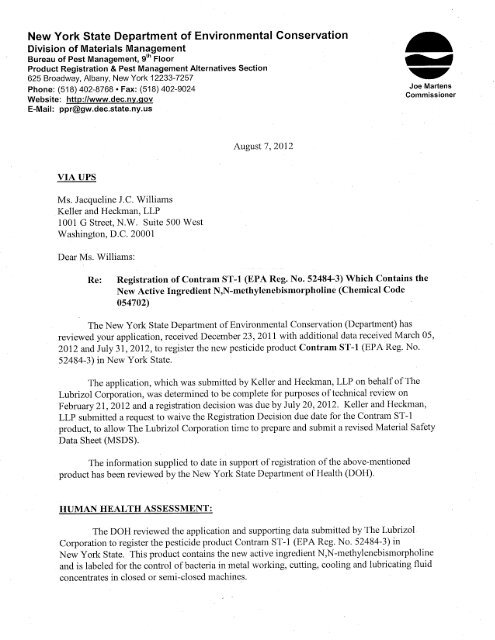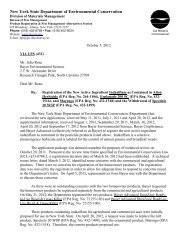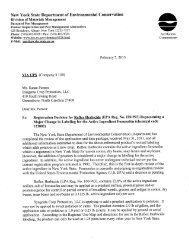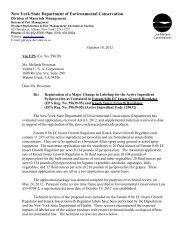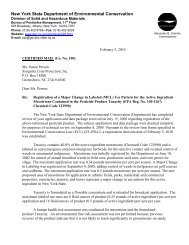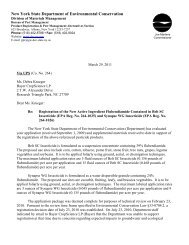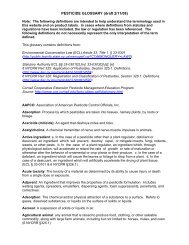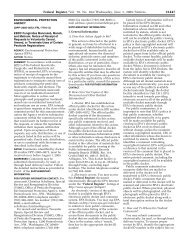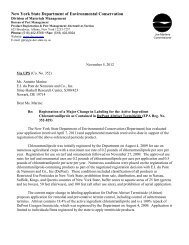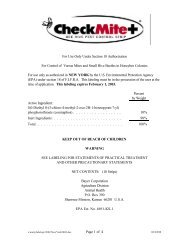n,n-methylenebismorpholine - Registration of Contram ST-1
n,n-methylenebismorpholine - Registration of Contram ST-1
n,n-methylenebismorpholine - Registration of Contram ST-1
You also want an ePaper? Increase the reach of your titles
YUMPU automatically turns print PDFs into web optimized ePapers that Google loves.
New York State Department <strong>of</strong> Environmental Conservation<br />
Division <strong>of</strong> Materials Management<br />
Bureau <strong>of</strong> Pest Management, 9th Floor<br />
Product <strong>Registration</strong> & Pest Management Alternatives Section<br />
625 Broadway, Albany, New York 12233-7257<br />
Phone: (518) 402-8768 . Fax: (518) 402-9024<br />
Website: http://www.dec.nv.gov<br />
E-Mail: ppr@gw.dec.state.ny.us<br />
VIA UPS<br />
Ms. Jacqueline J,C. Williams<br />
Keller and Heckman, LLP<br />
1001 G Street, N.W. Suite 500 West<br />
Washington, D.C. 20001<br />
Dear Ms. Williams:<br />
Re<br />
August 7,2072<br />
<strong>Registration</strong> <strong>of</strong> <strong>Contram</strong> <strong>ST</strong>-1 (EPA Reg. No. 52484-3) Which Contains the<br />
New Active Ingredient N,N-<strong>methylenebismorpholine</strong> (Chemical Code<br />
0s4702)<br />
Joe Martens<br />
Commissioner<br />
The New York State Department <strong>of</strong> Environmental Conservation (l)epartment) has<br />
reviewed your application, received December 23,2011 with additional data received March 05,<br />
2012 andJuly 3I,2012, to register the new pesticide product <strong>Contram</strong> <strong>ST</strong>-1 (EPA Reg. No'<br />
52484-3) in New York State.<br />
The application, which was submitte
Ms. Jacqueline J.C. Williams<br />
On an acute basis, N,N-<strong>methylenebismorpholine</strong> (the formulated product consists solely<br />
<strong>of</strong> the active ingredient and hydrolysis byproducts) was not very toxic to laboratory animals by<br />
either the oral or dermal routes <strong>of</strong> exposure. Although an acute inhalation toxicity study was not<br />
conducted, this active ingredient was assigned Toxicity Category I (highly toxic) given its<br />
hydrolysis to formaldehyde in the presence <strong>of</strong> water. N,N-<strong>methylenebismorpholine</strong> was<br />
corrosive to the skin (tested on rabbits) and was assum"d to also be corrosive to eyes (no testing<br />
was conducted), but was not a skin sensitizer (tested on guinea pigs).<br />
Because,<strong>of</strong> the use pattern, limited toxicity testing <strong>of</strong> N,N-<strong>methylenebismorpholine</strong> was<br />
required for the federal registration <strong>of</strong> <strong>Contram</strong> <strong>ST</strong>-1. In a 90-day feeding study in rats, N,N<strong>methylenebismorpholine</strong><br />
caused microscopic changes to the non-glandular stomach at 50<br />
milligrams per kilogram body weight per day (mglkglday); the no-observed-effect level (NOEL)<br />
was 15 mglkglday. This chemical did not cause developmental toxicity in <strong>of</strong>fspring <strong>of</strong> pregnant<br />
rats when administered by gavage during organogenesis at 100 mglkg/day, the highest dose<br />
tested. However, maternal toxicity charactenzed by treatment-related stomach effects inclucling<br />
erosion and granular aspect <strong>of</strong> the stomach occurred at 30 mglkglduy; the NOEL was 10<br />
mglkglday. N,N-<strong>methylenebismorpholine</strong> was also negative in a number <strong>of</strong> genotoxicity studies.<br />
The U.S. Environmental Protection Agency (U.S. EPA) waived all other toxicity studies<br />
including chronic toxicity/oncogenicity and developmental/reproductive toxicity studies for<br />
federal rãgistration <strong>of</strong> <strong>Contram</strong> <strong>ST</strong>-1. A search <strong>of</strong> the toxicological literature did not find any<br />
additional si gnifi cant information.<br />
The U.S. EPA reported the results <strong>of</strong> an occupational risk assessment for exposures to<br />
formaldehyde from the use <strong>of</strong> <strong>Contram</strong> <strong>ST</strong>-1 in metal working machine shops' N,Nrnethylenetismorpholine<br />
rapidly hydrolyzes to formaldehyde in the presence <strong>of</strong> water and due to<br />
formiaenyae's high vapor pressure (1 mm Hg), inhalation is the primary route <strong>of</strong> exposure. For<br />
determining margins-<strong>of</strong>-.*porrrr. (MOEs) to formaldehyde, the U.S. EPA compared estimated<br />
inhalation exposures to the reference concentration (RfC) <strong>of</strong> 0.1 parts per million (ppm) adopted<br />
by rhe Integrated Risk Information System (IRIS). The RfC is based on the NOEL <strong>of</strong> 0.1 ppm<br />
from an observational study with particle board workers (complaints <strong>of</strong> eye, nose, and throat<br />
irritation at 0.4-1 .0 ppm formaldehyde) and an uncertainty factor <strong>of</strong> 1. The U.S. EPA estimated<br />
inhalation exposures to formaldehyde from the use <strong>of</strong> metal working fluids treated with <strong>Contram</strong><br />
<strong>ST</strong>-l in closed and semi-closed máchines from information available in the open literature and<br />
data from a registrant conducted machinist exposure study (machining <strong>of</strong> cast metal parts using a<br />
water-based metal working fluid), Typical levels <strong>of</strong> fonnaldehyde in the air generated using<br />
metalworking fluids containing <strong>Contram</strong> <strong>ST</strong>-1 at the label application rate <strong>of</strong> 2,000 pp- a<br />
(approximately 300 ppm free formaldehyde) were esfimated to range from 1'1 x 10-' to 3.3 x 10-'<br />
ppm. These estimates <strong>of</strong> exposure to fontraldehyde through typical use in a machine shop do not<br />
exceed the U.S. EPA's level <strong>of</strong> concern (RfC) <strong>of</strong> 0.1 ppm. .In addition, the U.S. EPA did not<br />
estimate cancer risk from formaldehyde exposure from the labeled use <strong>of</strong> <strong>Contram</strong> <strong>ST</strong>-1 because<br />
it was assumed that the non-cancer risk level <strong>of</strong> 0.1 ppm would be protective <strong>of</strong> cancer risk as<br />
well. The U.S. EPA considered risk estimates from exposure to formaldehyde protective <strong>of</strong><br />
exposures to the parent N,N-<strong>methylenebismorpholine</strong>.<br />
There are no chemical specific federal or New York State drinking water/groundwater<br />
standards for N,N-<strong>methylenebismorpholine</strong>. Based on its chemical structure, this cornpouncl falls<br />
under the 50 microgram per liter fuglQ New York State drinking water standard for "unspecified<br />
organic contaminants" (10 NYCRR Part 5, Public Water Systems).<br />
2.
Ms. Jacqueline J.C. Williarns<br />
The available information on the aotive ingredient N,N-methylenebisrnorpholine<br />
indicates that it is corrosive and caused some toxicity in laboratory animals studies. Of greater<br />
concelat, however, is its rapid hydrolysis to formaldehyde, a probable human carcinogen, in the<br />
presence <strong>of</strong> water. The estimated exposures to fonnaldehyde <strong>of</strong> workers handling Contrarn <strong>ST</strong>-1<br />
through operating machinery that uses metalworking fluids treated with this product are<br />
estimated to be in the acceptable range by the U.S. EPA. In addition, the extensive personal<br />
protective equipment (PPE) required by label (coveralls over long-sleeved shirt and long pants,<br />
socks and chemical resistant foot wear, chemical resistant gloves, protective eyewear and a<br />
respirator with organic vapor removing oartridge for open pour systems or access to such a<br />
respirator for closed loading systems) should mitigate exposures and provide adequate MOEs to<br />
workers exposed through metal working operations or handling the concentrated product.<br />
However, the DOH has concerns about worker exposure to formaldehyde through use <strong>of</strong><br />
the <strong>Contram</strong> <strong>ST</strong>-1 product. The U.S. EPA did not conduct a cancer risk assessment for<br />
inhalation exposure to formaldehyde although an inhalation unit risk <strong>of</strong> 1.3 x 10-5 per pglrn3<br />
(based on increased incidence <strong>of</strong> squanrous cell carcinoma in rnale rats) is available and<br />
supported in the U.S. llPA's Integrated l{isk Information System (IIUS) database. Using the<br />
prãvlouslymentioned formaldehycle exposure concentrations (1.1 x 10'3 to 3.3 x 10¡ ppm) and<br />
the inhalation unit risk, a lifetime excess carloer risk range <strong>of</strong> 2 x 10-6 to 6.25 x 10-6 can be<br />
estimated for exposure to formaldehyde in machine shops. DOII recognizes that these<br />
calculations likely overestimate worker risks and the estimated range is only slightly greater than<br />
the target risk level <strong>of</strong> 1 x 10-6. Ilowever, DOH has concems about registering a product that<br />
exposes workers to a compound classified by the tl.S. EPA as a "probable human carcinogen"<br />
and considered by the National Toxicology Program (NTP) as "known to be a human<br />
carcinogen." The personal protective equipment required by the <strong>Contram</strong> <strong>ST</strong>-1 label should<br />
reduce potential exposure to formaldehyde; however we believe that workers should be aware <strong>of</strong><br />
this potential. Therefore, the DOI-I stated that they did not support registration <strong>of</strong> the <strong>Contram</strong><br />
<strong>ST</strong>-1 product in New York State atlhat tirne, but would be willing to support registration if the<br />
registrant added a statement to the product label, Material Safety Data Sheet (MSDS) or some<br />
other notification provided to workers alerting to the factthat f'ormaldehyde is fonned during the<br />
use <strong>of</strong> this product.<br />
In response to the conceffrs presented by the DOI-I in a "technical issues" letter dated<br />
June 15, 2012, the registrant submitted a revisecl MSDS. Specifically, Section 10 <strong>of</strong> the MSDS<br />
has been revised to alert workers to the fact that fonnaldehyde is formed during the use <strong>of</strong> the<br />
<strong>Contram</strong> <strong>ST</strong>-l produot.<br />
REGI<strong>ST</strong>RATION DECISION<br />
When used as labeled, <strong>Contram</strong> <strong>ST</strong>-1 has the potential to expose workers to<br />
formaldehyde, which is classified by the U.S. EPA as a "probable human carcinclgen" and<br />
considered by the National Toxicology Program (N'l-P) as "known to be a human catcinogen."<br />
The personal protective equipment required by the <strong>Contram</strong> <strong>ST</strong>-1 label should reduce potential<br />
exposure to fonnaldehyde; however the Department believes that workers should be aware <strong>of</strong><br />
this potential. With the addition <strong>of</strong> the revised MSDS, alerting workers to the fact that<br />
J
Ms, Jacqueline i.C. Williams<br />
formaldehyde is formed during the use <strong>of</strong> this.product, the Department is willing to support<br />
registration <strong>of</strong> <strong>Contram</strong> S'f-1 (EPA Reg. No. 52454-3). Overall, the registrant addressed the<br />
DOH's concerns with the revised MSDS.<br />
'l'herefore, the Departmcnt has registered <strong>Contram</strong> <strong>ST</strong>-1 (EPA Reg. No. 52484'3)<br />
for usc in New York Statc.<br />
Enclosed are copies <strong>of</strong> the stamped "Accepted for <strong>Registration</strong>" label and the New York<br />
State Certificate <strong>of</strong> Pesticide <strong>Registration</strong> for the product'<br />
Please note that a proposal by any registrant to register a product that contains N,N<strong>methylenebismorpholine</strong>,<br />
and whose labeled use are likely to increase the potential for signifrcant<br />
impact on humans, nontarget organisms, or the envirorunent, would constitute a major change in<br />
labeling. Such an application must be accornpanied by a new application fee and meet the<br />
requirements listed in Appendix 1.8 <strong>of</strong> "New York State Pesticide Product <strong>Registration</strong><br />
Procedures" (April 2O0g). Such information, as well as forms, can be accessed at our website as<br />
listed in our letterhead<br />
If you have any questions, please contact Ms. Cyndi Crowley, <strong>of</strong> our Product <strong>Registration</strong><br />
and Pest Management Alternatives Section, at (518) 402-8768.<br />
Enclosures<br />
Sincerely,<br />
5zr^-Æ/4'/-¿"1/4Årc<br />
Scott Menrath, P.E.<br />
Director<br />
Bureau <strong>of</strong> Pest Management<br />
4


